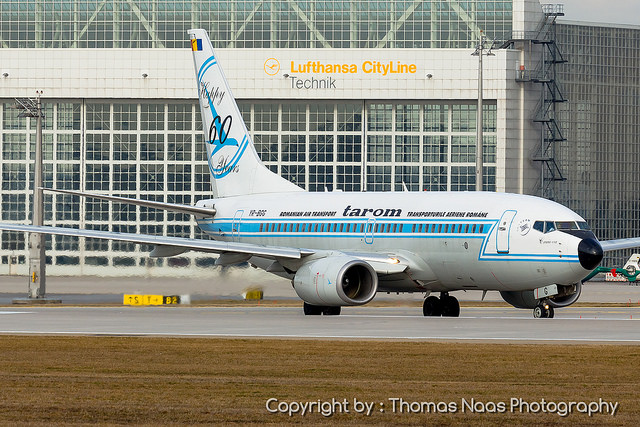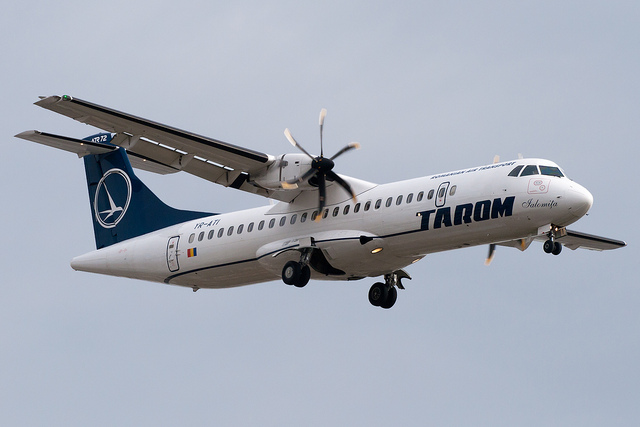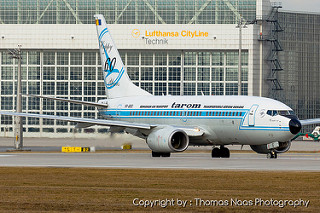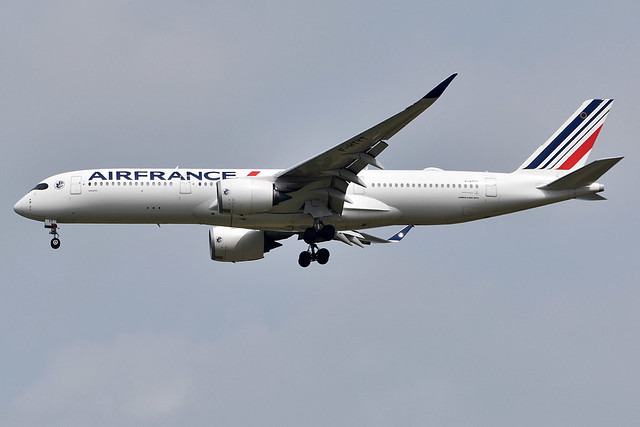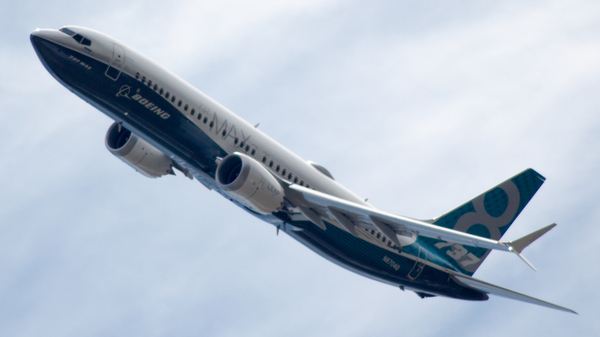TAROM AT42 at Chisinau on Jun 4th 2017, runway excursion on landing
Last Update: September 30, 2020 / 16:03:10 GMT/Zulu time
Incident Facts
Date of incident
Jun 4, 2017
Classification
Incident
Cause
Runway excursion
Airline
Tarom
Flight number
RO-207
Departure
Bucharest Otopeni, Romania
Destination
Chisinau
Aircraft Registration
YR-ATB
Aircraft Type
ATR ATR-42
ICAO Type Designator
AT42
Airport ICAO Code
LUKK
The runway was closed for about 2 hours until the aircraft was moved off the runway.
The airline reported, that at the time of landing when the brakes were applied the aircraft made some abnormal movements for still unknown reasons. Despite efforts by the crew to keep the aircraft on the runway the aircraft went slightly off the runway.
The occurrence aircraft is still on the ground in Chisinau 4 days after landing (standing Jun 8th 2017).
On Jun 8th 2017 Romania's AIB reported the occurrence was rated a serious incident and is being investigated by Romania's AIB. There were no injuries, the aircraft sustained minor damage.
On Sep 30th 2020 Romania's AIAS released their final report concluding the probable cause of the serious incident was:
The probable cause of this serious incident is the inadequate operation of the control column and rudder pedal after the aircraft touchdown, which led to the partial loss of aircraft control during rolling and to the impossibility of maintaining it within the runway rolling surface limits.
Contributing factors:
- Failure to perform the Descent Check during the approach flight;
- Failure to correct heading deviation smoothly, using the rudder above 70 kt and progressively the steering (hydraulic nose wheels control system on ground) below 70 kt;
- Failure to operate the aircraft braking system.
The AIAS analysed:
The approach and touchdown were performed by the First Officer, as the Pilot Flying (PF), and the pilot in command was to take control after touchdown for braking the aircraft and performing the run after landing.
According to the standard procedure, if CM2 (pilot on the right-hand seat) is PF and CM1 (pilot on the left-hand seat) is PM, after touchdown, until the announcement of the 70 kt speed by PM, the aircraft controls are the responsibility of PF, the steering being taken over by the pilot in command (pilot on the left-hand seat) at the announcement of the 70 kt speed.
During the ILS approach to runway 08 (magnetic head 83º), the aircraft was configured with flaps 35º, stabilized on the slope and direction, maintaining an indicated speed between 114 - 120 kt.
To counteract the lateral wind influence, the crew operated the control column and the rudder to keep the aircraft stabilized on the localizer (runway heading), respectively the aileron input into the wind to cancel the wind influence and the rudder to the left to control yaw and to keep the aircraft on the runway axis.
According to the data recorded by DFDR and analyzed by the investigation commission, it was found that at 15:11:47 the aircraft touched down the runway on both main landing gears.
For the next two seconds, after touchdown, the rudder position was 13.2⁰ to the left (the maximum value being of 30⁰) and remained around this value for 1 second.
At 15:11:49 the rudder was reduced to a value of 2.2⁰ (value close to the neutral position) the aircraft moving to the right, recording a 5º increase of the magnetic heading, from 083º to 088º. The ground speed of the aircraft was 111 kt.
At 15:11:50, a rudder input was recorded to the maximum left (29.9°) for 4 seconds, the value of the lateral acceleration being of 0.32 G, the magnetic heading decreasing rapidly from 088º to 075º. The aircraft ground speed decreased from 111 kt to 79 kt.
At 15:11:54 the rudder control to the left was released and rudder control to maximum right was applied, this value being recorded for 3 seconds.
The aircraft rapidly changed its moving direction (maximum rate +10.9°/s) from 75º to 110º, a lateral acceleration of 0.65 G being recorded. The change of direction occurred at approximately 770 m after the runway threshold. The engine control handles were positioned from Ground Idle to Reverse. The aircraft ran for about 200 m heading 110º with a decreasing speed from 79 kt to 51 kt before exiting the runway to the right, on the grassy surface.
Although the speed decreased below 70 kt, the pilot in command did not operate either the steering to control the aircraft roll on the ground or the aircraft's braking system.
Just before leaving the runway surface, at 15:11:57 UTC, the crew operated the rudder and the ailerons to the maximum left, maintaining this input for 8 seconds while the aircraft ran on the grassy surface on the runway side area.
At 15:12:04 the aircraft exited the runway to the right.
At 15:12:06 the steering control to the left was slightly reduced to approximately 16⁰ for 4 s.
At 15:12:10, at almost 1080 m after the runway threshold, the aircraft re-entered the runway, hitting with the right-hand main landing gear wheels a concrete block on which a light beacon was mounted and continued running at a low speed (20-30 kt). At this speed the aerodynamic controls no longer had a directional effect, the trajectory being determined by the asymmetric thrust generated by the aircraft engines.
The aircraft crossed the runway axis, stopping at 15:12:15 on the left side of the runway on the grassy surface.
In the opinion of the investigation commission, from the moment the aircraft touched down the runway with all three landing gears and began to deviate to the left of the runway axis (640 m after the runway threshold), the rudder pedal controls applied to bring the aircraft on the runway axis were too wide, the rudder values ranging from maximum left to maximum right. Within 15 seconds the rudder was actuated to maximum values three times in a row (left 4 s - right 3 s - left 8 s).
Throughout the ground evolution of the aircraft, the crew did not use the steering system or the aircraft's braking system, which contributed to the partial loss of aircraft control during rolling.
The aircraft's ground rolling was characterized by rapid and extensive changes of direction, which is also confirmed by the high values of lateral acceleration.
The rudder pedal controls are initially used to keep the aircraft on the runway axis and any deviation must be corrected by smoothly amplitude inputs.
Overcorrections can cause oscillations of the aircraft's ground trajectory, which can lead to loss of control during roll.
The actions to be taken in crosswind landings are well specified in the updates made in Operations in Wind Conditions section (PRO.NOP.ANOR.8.2 OPERATIONS IN WIND CONDITIONS) in FCOM 10.0 JUL20 - Introduction in FCOM of FOIM 2016/06 Issue 1“Crosswind Landing” in order to prevent runway excursion in crosswind landing as well as the familiarization of the operator’s ATR pilots.
By analyzing the conversations between the pilots recorded by CVR, the investigation commission concluded that there was a moment of uncertainty, immediately after the aircraft touched down the runway, related to whom had the aircraft control (The First Officer to the pilot in command „Yours, yes?”).
The aircraft evolution on the ground, corroborated with the moment of uncertainty related to whom had the aircraft control, generated the inadequate operation of the control column and rudder pedals to bring the aircraft back on the runway axis, as well as the partial loss of its rolling control.
Wide rudder pedal controls, failure to use the ground steering control system and the aircraft's braking system, made it impossible to keep the aircraft within the runway's running rolling surface limits.
By analyzing the conversations between the pilots recorded on the CVR, the investigation commission found that during the approach flight, the crew did not perform the Descent Checklist.
Checklists are standard operating procedures provided in the operator's Operations Manual, which provide actions to be followed before, during and after the critical phases of the flight (take-off, landing), as well as in emergency situations.
The Descent Checklist is performed during the approach flight. It includes, in addition to checking the aircraft systems operation, the “Landing brief” section.
In this section the crew performs the following actions:
- reviewing the approach and landing standard procedure for the runway
in service;
- checking the frequency of the radio-navigation device used for the approach;
- establishing the aircraft configuration for landing and the approach and touchdown speeds, depending on the aircraft weight, the available runway length, the air temperature and atmospheric pressure, the wind direction and speed;
- reviewing the missed approach landing procedure;
- operation mode in case of unforeseen situations;
- review and brief crosswind landing technique for the decrab, flare and landing roll, prior to the approach;
- how to take control of the aircraft, after touchdown, when PF (Pilot Flying) is the First Officer.
The moment of uncertainty related to whom had the aircraft control was
generated by the fact that the crew did not perform the Descent Checklist and did not establish the time and manner of taking the aircraft command by the pilot in command.
From the investigations of serious incidents involving other ATR aircraft of the same operator, it was found that the fact of performing superficial checklists or no checklists at all, during certain flight stages, has become a fairly common practice among crews, a practice caused by routine.
The investigation commission considers that an important element that led to the partial loss of aircraft control during rolling was the lack of a complete and correct briefing on landing maneuvers.
Familiarization of the operator’s ATR pilots with the brake operation mode and braking efficiency is performed only when the pilots begin the training program in view to obtain the pilot in command qualification although, according to the standard procedure, if CM2 (the pilot on the right-hand seat) is PF and CM1 (the pilot on the left-hand seat) is PNF, after touchdown, until the announcement of the 70 kt speed by PNF, the aircraft controls are the responsibility of PF, steering and braking being taken over by the pilot in command (the pilot on the left-hand seat) at the announcement of 70 kt speed.
In practice, First Officers, even when they are PFs, do not operate the aircraft's brakes after touchdown, the braking being done exclusively by the pilot in command. This practice is probably also used due to the fact that the ATR-42 aircraft rarely uses the braking system, immediately after touchdown, reducing the speed to the value of the runway clearance speed being ensured by the available runway length and the power levers retraction from Flight idle to Ground idle.
Related NOTAM:
A0159/17 NOTAMR A0158/17
Q) LUUU/QFALC/IV/NBO/A /000/999/4656N02856E005
A) LUKK B) 1706041614 C) 1706041730 EST
E) AD CLOSED DUE TO ACFT ON RWY.
A0158/17 NOTAMN
Q) LUUU/QFALC/IV/NBO/A /000/999/4656N02856E005
A) LUKK B) 1706041548 C) 1706041630 EST
E) AD CLOSED DUE TO ACFT ON RWY.
Metars:
LUKK 041700Z 17016KT CAVOK 23/13 Q1015 R08/CLRD// NOSIG=
LUKK 041630Z 17015KT CAVOK 24/13 Q1015 R08/CLRD// NOSIG=
LUKK 041600Z 17014KT CAVOK 25/14 Q1014 R08/CLRD// NOSIG=
LUKK 041530Z 17016KT CAVOK 25/13 Q1015 R08/CLRD// NOSIG=
LUKK 041500Z 17014KT CAVOK 25/13 Q1015 R08/CLRD// NOSIG=
LUKK 041430Z 17014KT CAVOK 25/13 Q1015 R08/CLRD// NOSIG=
LUKK 041400Z 17012KT CAVOK 26/14 Q1015 R26/CLRD// NOSIG=
LUKK 041330Z 19012KT 160V220 9999 SCT049 27/14 Q1015 R26/CLRD// NOSIG=
LUKK 041300Z 17012KT 9999 BKN049 27/14 Q1015 R26/CLRD// NOSIG=
LUKK 041230Z 20010KT 150V250 9999 SCT049 27/13 Q1016 R08/CLRD// NOSIG=
LUKK 041200Z 19012KT 150V220 9999 SCT049 26/13 Q1016 R08/CLRD// NOSIG=
LUKK 041130Z 18011KT 9999 SCT049 27/13 Q1016 R26/CLRD// NOSIG=
LUKK 041100Z 18012KT 150V210 9999 SCT049 26/13 Q1016 R26/CLRD// NOSIG=
Incident Facts
Date of incident
Jun 4, 2017
Classification
Incident
Cause
Runway excursion
Airline
Tarom
Flight number
RO-207
Departure
Bucharest Otopeni, Romania
Destination
Chisinau
Aircraft Registration
YR-ATB
Aircraft Type
ATR ATR-42
ICAO Type Designator
AT42
Airport ICAO Code
LUKK
This article is published under license from Avherald.com. © of text by Avherald.com.
Article source
You can read 2 more free articles without a subscription.
Subscribe now and continue reading without any limits!
Read unlimited articles and receive our daily update briefing. Gain better insights into what is happening in commercial aviation safety.
Send tip
Support AeroInside by sending a small tip amount.
Related articles
TAROM B737 at Paris on Apr 2nd 2025, rejected takeoff
A TAROM Boeing 737-700, registration YR-BGG performing flight RO-384 from Paris Charles de Gaulle (France) to Bucharest Otopeni (Romania), was…
Tarom AT72 at Satu Mare on Mar 10th 2025, bird strike on roll out
A Tarom Avions de Transport Regional ATR-72-212A, registration YR-ATI performing flight RO-637 from Bucharest Otopeni to Satu Mare (Romania) with 32…
TAROM B737 near Bucharest on Nov 21st 2024, packs problem
A TAROM Boeing 737-700, registration YR-BGG performing flight RO-381 from Bucharest Otopeni (Romania) to Paris Charles de Gaulle (France), was…
TAROM B738 at Paris on Mar 24th 2024, engine failure
A TAROM Boeing 737-800, registration YR-BGJ performing flight RO-384 from Paris Charles de Gaulle (France) to Bucharest Otopeni (Romania) with 117…
TAROM AT72 at Budapest on Nov 12th 2023, tyre damage on landing
A TAROM Avions de Transport Regional ATR-72-212A, registration YR-ATL performing flight RO-237 from Bucharest Otopeni (Romania) to Budapest (Hungary)…
Newest articles
France A359 at Buenos Aires on Nov 20th 2025, smell of smoke on board
An Air France Airbus A350-900, registration F-HTYT performing flight AF-411 from Buenos Aires Ezeiza,BA (Argentina) to Paris Charles de Gaulle…
United B38M near Salt Lake City on Oct 16th 2025, cracked windshield, collision with weather balloon
A United Boeing 737-8 MAX, registration N17327 performing flight UA-1093 from Denver,CO to Los Angeles,CA (USA) with 140 people on board, was enroute…
Subscribe today
Are you researching aviation incidents? Get access to AeroInside Insights, unlimited read access and receive the daily newsletter.
Pick your plan and subscribePartner

ELITE Simulation Solutions is a leading global provider of Flight Simulation Training Devices, IFR training software as well as flight controls and related services. Find out more.
SafetyScan Pro provides streamlined access to thousands of aviation accident reports. Tailored for your safety management efforts. Book your demo today
AeroInside Blog
Popular aircraft
Airbus A320Boeing 737-800
Boeing 737-800 MAX
Popular airlines
American AirlinesUnited
Delta
Air Canada
Lufthansa
British Airways
